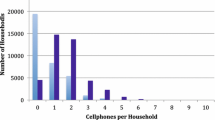Abstract
Lifeline programs sponsored by the Federal Communications Commission (FCC) in cooperation with the states and Local Exchange Companies (LECs) are authorized to increase telephone penetration. Estimates of a variant of Perl's (1983) economic model with 1990 Census Data broken to the state level indicate that expenditures on these programs have a positive statistical effect on telephone penetration in most models. However, program elasticities are extremely small, suggesting that very large expenditure increases per poor household would have little effect on telephone penetration. Importantly, there is no relationship between the size of the state program elasticity and the level of state income or the magnitude of state poverty. We also demonstrate that the 1990 Census Data is superior to the Current Population Survey as a data base.
Similar content being viewed by others
References
Amemiya, T. 1985. Advanced Econometrics. Cambridge. Mass: Havard University Press.
Amemiya, T. 1981. “Qualitative Response Models: A Survey.” Journal of Economic Literature 19: 1483–1536.
Albery, B. 1994. “What Level of Dialtone Penetration Constitutes ‘Universal Services’?” Columbus: Ninth NARUC Biennial Regulatory Conference.
Eriksson, R.C., D.L. Kaserman, and J.W. Mayo. 1995. “Targeted and Untargeted Subsidy Schemes: Evidence from Post-Divestiture Efforts to Promote Universal Telephone Service.” New Orleans: Southern Economic Association Meetings.
Greene, W. 1993 Econometric Analysis. 2nd ed., New York: Prentice-Hall.
Hausman, J., T. Tardiff, and A. Belinfante. 1993. “The Effects of the Breakup of AT&T on Telephone Penetration in the United States.” American Economic Association Papers and Proceedings 83: 178–184.
Johnson, L.L. 1988. Telephone Assistance Programs to Low-Income Households. R-3603-NSF/MF Palo Alto: Rand Corporation.
Kaserman, D. L., J.W. Mayo, and J.E. Flynn. 1990. “Cross Subsidization in Telecommunications: Beyond the Universal Service Fairy Tale.” Journal of Regulatory Economics 21: 231–249.
Maddala, G.S. 1983. Limited Dependent and Qualitive Variables in Econometrics. Econometric Society Monographs, No. 3. Cambridge, Eng.: Cambridge University Press.
Mueller, M. 1993. “Universal Service in Telephone History.” Telecommunications Policy (July): 352–369.
Perl, L.J. 1983. Residential Demand for Telephone Service. White Plains: National Economic Research Associates.
Schement, J.R., A. Belinfantc, and L. Povich. 1994. Telephone Penetration 1984–1994. Washington, DC: FCC.
Taylor, L.D. 1980. Telecommunications Demand: A Survey and Critique. Cambridge, Mass.: Ballinger Publishing Co.
Taylor, L.D. 1994. Telecommunications Demand In Theory and Practice. Boston: Kluwer.
Walters, J.C. 1992. “Assessing the Effectiveness of Residential Rate Assistance Programs in Furthering the Goal of Universal Service.” Columbus: Eighth NARUC Biennial Regulatory Information Conference.
Rights and permissions
About this article
Cite this article
Garbacz, C., Thompson, H.G. Assessing the Impact of FCC Lifeline and Link-Up Programs on Telephone Penetration. Journal of Regulatory Economics 11, 67–78 (1997). https://doi.org/10.1023/A:1007902329324
Issue Date:
DOI: https://doi.org/10.1023/A:1007902329324




